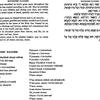1: Mourner’s Kaddish (Kaddish Yatom), text in Aramaic, in transliteration, and in English translation.
The title and content of Ginsberg’s poem make explicit references to the Mourner’s Kaddish. This prayer, written in Aramaic, appears regularly in Jewish liturgy. Traditionally, it is recited daily by the bereaved—in the case of a parent, for eleven months—and again on the anniversary (yartzheit) of a death. In its current form, the Mourner’s Kaddish most likely entered Jewish liturgy during the time of the Crusades as a reaction to violence against European Jewish communities. These resources will allow students to engage with the text of the poem on the levels of meaning and of sound/rhythm, each of which plays an important role in shaping Ginsberg’s Kaddish.
You can listen to the Mourner's Kaddish in two different dialects here and here.
Suggested Activity: Before distributing the texts, ask students if they are familiar with the Mourner’s Kaddish. Ask them if they know what it’s “about.” Some students may expect it to be a prayer explicitly discussing death; their responses can help to guide the discussion that follows. Distribute the text and ask students to follow along as you play the audio. Ask them to identify the most important concepts contained in the prayer. How, if at all, are these concepts deployed in Ginsberg’s poem? (You may wish to look specifically at Part II, “Hymmnn,” and Part V of the poem.)
Source: Ha-Siddur Ha-Shalem (Daily Prayer Book), translated and annotated by Philip Birnbaum (New York: Hebrew Publishing Company, 1949), 137-38.
Mourners_kaddish_resource.jpg
 Download image (1002.33 KB)
Download image (1002.33 KB)

